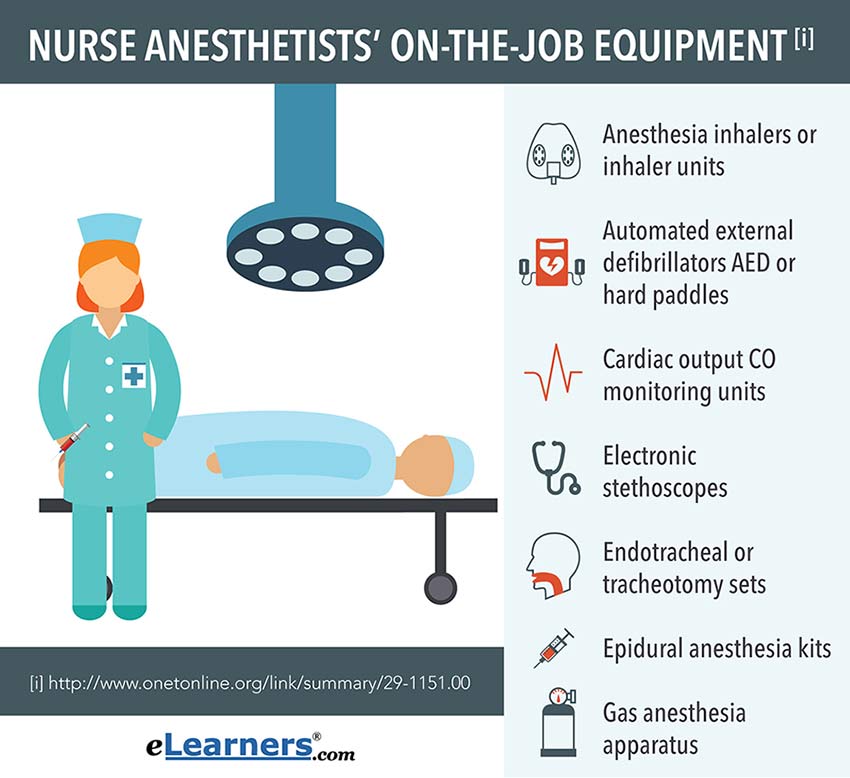by Jill Kapinus
What is a Nurse Anesthetist?
Are you looking to become a nurse anesthetist? It may be a good opportunity to go into a very specific field of nursing, or to enhance your existing nursing education and experience. But if you’re scratching your head wondering, “What is a nurse anesthetist?”, chances are you may have already come into contact with one—especially if you’ve ever been put to sleep for surgery or to have your wisdom teeth removed.

The primary responsibilities of a nurse anesthetist are to administer anesthesia to a patient, monitor that patient’s vital signs, and then supervise the patient’s recovery from anesthesia. Nurse anesthetists are also responsible for preparing the proper medication and equipment for the procedure to be performed, monitoring patients’ physical reactions to anesthesia (such as pulse, heart rate, respiration, pupil dilation, etc.), performing pre-anesthetic screenings, and obtain consent forms. Critical thinking, reading comprehension, active learning/listening, and monitoring are just some of the skills that nurse anesthetists need to use on a regular basis.
Here are some tools that many nurse anesthetists use frequently when on the job i:
- Anesthesia inhalers or inhaler units
- Automated external defibrillators AED or hard paddles
- Cardiac output CO monitoring units
- Electronic stethoscopes
- Endotracheal or tracheotomy sets
- Epidural anesthesia kits
- Gas anesthesia apparatus
Sometimes, nurse anesthetists also have to record patient medical histories, gather medical information from doctors or family members of patients, analyze test results in order to treat or diagnose, and examine a patient's overall physical condition.
Nurse Anesthetist Degree Requirements
In learning how to become a nurse anesthetist, it helps to know that this type of nursing specialty may be referred to as an APRN (advanced practice registered nurse). APRN’s must be licensed registered nurses in their state and pass a national certification exam. This profession also requires having earned a master’s degree.ii.
According to the American Association of Nurse Anesthetists (AANA), in order to become a certified registered nurse anesthetists, a nurse needs a bachelor’s degree, a registered nurse license, at least one year acute care experience, and the successful completion of both the national certification examination and an accredited nurse anesthesia master’s program iii. Throughout a nurse anesthetists’ career, they also need to earn recertification—which includes, among other requirements, successfully completing a minimum of 40 hours of approved continuing education every two years and maintaining a current state license iv.
How Much Does a Nurse Anesthetist Make?
The salary and benefits for a nurse anesthetist will always vary on location, type of employment, and years of experience, so there is no exact number tied to how much nurse anesthetists make. But according to the Bureau of Labor Statistics, here are some employment facts about the profession:
- Median annual salary in 2014: $153,780 v
- There are 36,590 nurse anesthetists employed in American as of 2014. v
- This job is expected to grow 22% or higher (much faster than average) from 2012 through 2022. i
The top three industries with the highest employment levels for nurse anesthetists are physicians' offices, general medical and surgical hospitals, and offices of other health practitioners—those three industries employing over 33,000 of the nurse anesthetists working nationwide v.
Just like many professions in healthcare, nurse anesthetists are part of a community that helps people and makes a difference in the lives of patients and their families. The ability to undergo surgery or procedures without feeling pain is an important puzzle piece in the big picture of healthcare. Pursuing the career path of a nurse anesthetist may allow you to combine your passion to help others and your desire to enhance your education and your existing healthcare career.
i onetonline.org/link/summary/29-1151.00 | ii bls.gov/ooh/healthcare/nurse-anesthetists-nurse-midwives-and-nurse-practitioners.htm#tab-4 | iii aana.com/ceandeducation/becomeacrna/pages/default.aspx | iv aana.com/ceandeducation/becomeacrna/Pages/Nurse-Anesthetists-at-a-Glance.aspx | v bls.gov/oes/current/oes291151.htm
